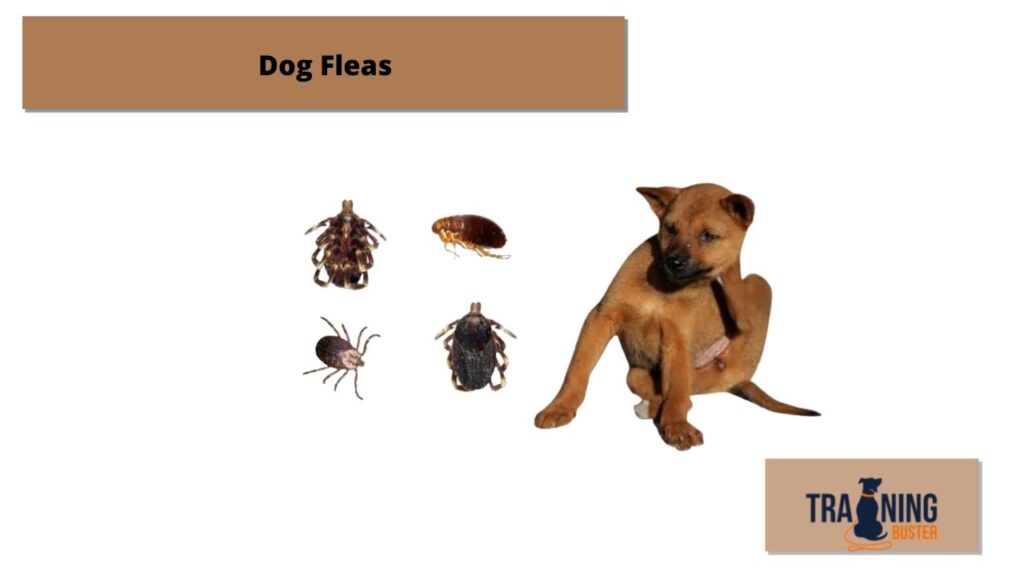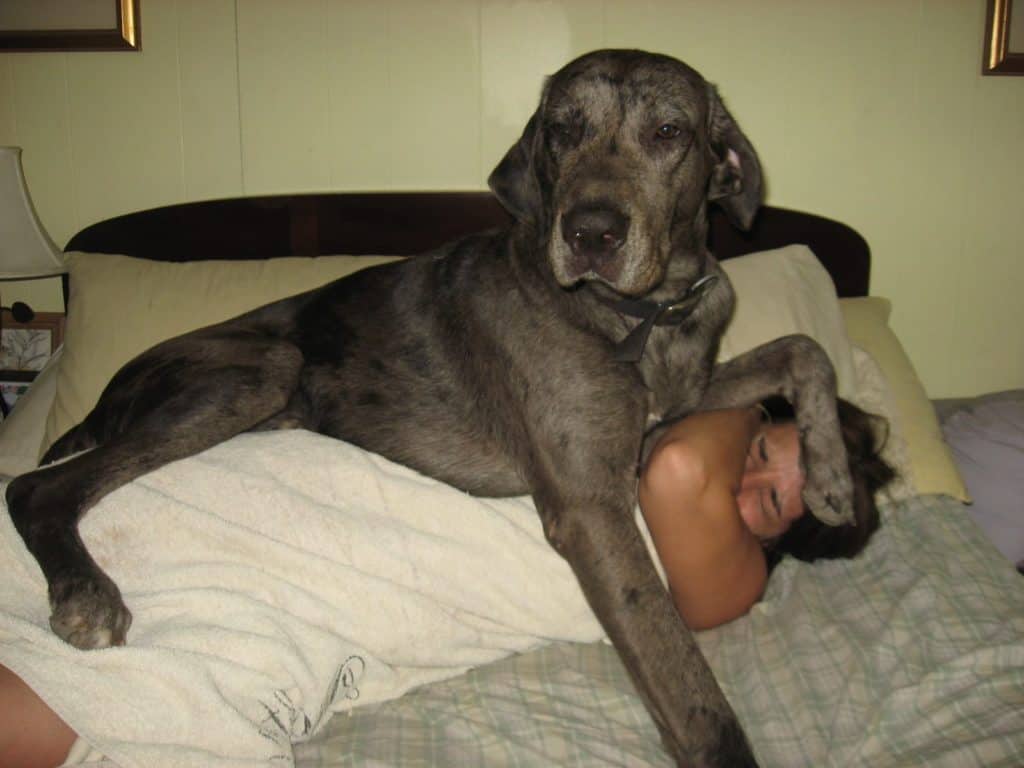
How to tell if your Dog Has Fleas? The Short answer is:
- Itching and scratching.
- Red pimples or bumps.
- Check your dog for fleas.
- Visual checks to see if your dog has fleas.
- Flea comb check dog.
Fleas are very active insects, feeding on blood from dogs and people. They jump onto passing animals and burrow down into the fur to the skin, where they stay well-hidden while biting and ingesting blood.
This is irritating to the animal, and to humans as well, as the bites can cause severe itching and inflammation. Left untreated, chronic infestations not only make your dog miserable but can lead to infection and more serious flea-related diseases.
Being aware of the signs and symptoms of flea infestations, along with prompt treatment, will help you keep your dog and her environment a healthy one.
Our recommenced Flea and tick treatments are:
- Richard’s Organics Flea Dog Shampoo
- Frontline Plus Flea & Tick Spot Treatment
- K9 Advantix II Flea & Tick Spot Treatment for Dogs
- Flea Comb for Dogs and Cats
Behavioral Signs when your dog has a flea infestation
In severe infestations, it’s easy to spot fleas jumping and moving on and off your dog’s body. In less obvious situations, you may notice that your dog is restless and is scratching, licking, or chewing more than normal on certain areas of its body. Shaking the head often and scratching at the ears is another indication of a possible flea infestation in your dog.
Symptoms of dog flea allergies
Itching and scratching
Like all parasites, fleas depend upon a host animal for their survival – in this case, your dog’s blood. Dogs can be allergic to the protein in flea saliva and will itch or scratch as soon as the flea bites the dog’s skin.
Even a single flea bite can cause a dog to become nervous or agitated and scratch excessively for several days.
Red pimples or bumps
These symptoms may appear on your dog’s groin or belly, under the legs, at the base of her tail, and on her behind (rump).
Constant itching or scratching of these areas can result in hair loss and dry skin. Left untreated, crusty lesions and infections can develop and lead to more severe flea-related diseases like.
- Dermatitis
- Murine Typhus
- Mycoplasma haemofelis
- Tapeworms
How to check your dog for fleas
Make it a habit to check your dog’s comb or brush during regular grooming sessions. If you suspect a problem, there are several ways to check your dog for fleas.
Visual check for fleas on your dog
Adult fleas are small and brown and are relatively easy to see with the naked eye. Have your dog lie on her side and check thinly-haired areas like her abdomen or the inside of her hindquarters.
Use a dog Flea comb
Fine-toothed, metal flea combs are available from your vet or local pet supply store. Here is a cheap one I use, you can find it here.
Run the comb along her back or underbelly making sure to apply enough pressure so the comb comes in contact with her skin. Adult flea feces – commonly called flea dirt – look like small black pepper specks.
Have a small bowl of soapy water handy to drown any adult fleas you may pull up with the comb so they don’t hop back onto your dog.
There are two main types of flea combs
- Tooth combs
- Electric combs
White towel flea test
Have your dog stand on a white paper towel or cloth. Brush or rub her coat and check to see if there are black droppings on the towel.
Flea dirt will look like tiny grains of sand and will turn red if the water is applied. If you can’t detect any fleas, flea dirt, or eggs, but your dog continues to scratch or seems uncomfortable, have your veterinarian check him over.
There is a skin test your vet can administer to test for flea allergies. It’s also possible that your dog is suffering from another type of allergy such as a food, atopic, or contact allergy which the vet can diagnose during your visit.
Checking the environment for fleas
Fleas don’t just stay on your dog. They can also be found all through your house, especially in areas where your dog spends a lot of her time.
Closely examine your dog’s feeding area, bedding, and her favorite locations for signs of flea dirt (black specks), or for the fleas themselves.
Another method you can use to search for flea dirt in the house is to wear white socks and walk through areas frequented by your dog. Fleas and/or flea dirt may be picked up by the fibers of the socks and will stand out on the white background.
Another method called a “light trap,” may also help detect the presence of fleas in the household.
At night, before all the lights have been turned off, set a small bowl of water with dishwashing soap near a nightlight on the floor. Fleas will tend to jump toward the light and will fall into the bowl, where they will drown. In the morning, you may find several floating in the water.
How to Make a Flea Trap
- Fill a large, shallow dish with water
- Add dish soap
- Place the trap where fleas have been
- Place a candle in the center of the dish or place a lamp above so the light shines on the water
- Leave the trap overnight in a dark room
- Empty and refill the trap each morning
Safely rid your dog and home of fleas
Adult fleas can continue to reproduce and thrive on your dog and in your home until you break their life cycle.
Fortunately, there are safe and effective treatment options. From powders and sprays to shampoos and topical liquids, numerous products are available to prevent or eliminate fleas and treat your dog’s surroundings.
Oral and topical flea control for your dog
Fleas are annoying and persistent. However, dog flea and tick pills and other spot-on dog flea and tick treatments have proven to be some of the fastest ways to rid your pet of fleas.
Some only target adults, while others target flea eggs, larvae, and adult fleas, so it’s important to buy the right one. Others will combine flea control and heartworm prevention in one treatment. You’ll notice that some require a prescription, while others do not. Talk to your vet about which option is the best for your pet.
Prescription flea medications for your dog and puppy
There are a wide variety of flea products on the market today, but the newer prescription flea and tick products are finally taking the frustration out of flea control with popular and highly effective brands.
Talk to your veterinarian about preventative flea and tick medicine for dogs, as many are prescription products. Prescription treatments present one of the best ways to kill fleas fast.
Bravecto (fluralaner) begins to kill fleas within two hours and lasts for three months, while products containing spinosad (Comfortis, Trifexis) begin to work within 30 minutes and last for one month.
Our recommenced dog Flea and tick treatments are:
Frontline Plus for Dogs (5-22 pounds) Find the latest price on Amazon here. DOG PILLS. Capstar Fast-Acting Oral Flea Treatment for Large Dogs, 6 Doses, 57 mg (26-125 lbs) Find it here on Amazon.
Flea and Tick Prevention Collar for Dogs 1 Year Protection Control Safe & Hypoallergenic & Waterproof & Adjustable Size 25 Inches Fits Most Dogs. Find it here on Amazon.
Some of these flea products do not harm the adult flea but instead prevent her eggs from hatching, thus breaking the life cycle of the flea.
With no reproduction, the flea population eventually dissipates as long as the pet isn’t coming in contact with new fleas continually.
In warm climates, prescription flea and tick treatment for dogs is typically a year-round endeavor, but in other climates, treatment should begin in early spring before the flea season starts.
For animals that are allergic to flea saliva (have flea bite hypersensitivity), choose a product that targets adult fleas as well, since they are still able to bite the animal.
For dogs with flea hypersensitivity, products containing a flea repellent (Seresto collar, Vectra 3D) are the best choice so that the fleas never bite.
There are also many other products that will kill fleas on the pet and for which no prescription is needed. The drawback, however, is that these products may be less effective than prescription products.
These nonprescription flea products include:
Many veterinarians are reporting that their patients still have fleas after use of these over-the-counter products, but there are also good reviews from pet parents for some of these products.
Capstar, for instance, is a tablet that kills adult fleas and is taken orally.
It begins to work within 30 minutes and kills more than 90 percent of all fleas within four hours. It is used to treat flea infestations.
Dog flea shampoos
There are several dog flea and tick shampoo options for dogs and cats on the market that can be quite effective when used properly. Flea dog shampoos may contain a variety of ingredients that are more or less effective. Small puppies should only be bathed in non-toxic dog shampoo.
You’ll need to consider whether or not your pet can stand getting soaking wet and being lathered up for five to 10 minutes, though, since that’s how long the shampoo takes to sink in.
Following a nice warm bath, you’ll have killed the fleas and will be able to use a dog flea and tick comb to remove the dead fleas from your dog. However, flea shampoos do not protect your dog from continued infestation with fleas. This is what I use and works great.
What is the life cyccle of dog fleas
But your quest to eliminate fleas isn’t over just yet—you also have to treat the environment. Simply sprinkling some flea powder on your pet will not work; simply vacuuming the home vigorously will not work, simply placing a dog flea collar or using a flea topical on your pet will not work.
In order to understand how each treatment option works and why you must also treat the environment, we must first understand the flea’s life cycle.
The various treatment and prevention products work on different parts of this life cycle. There are several stages to the flea life cycle: egg, larva, pupa (cocoon), and adult. The length of time it takes to complete this cycle varies depending upon the environmental conditions, such as temperature, humidity, and the availability of a nourishing host.
The life cycle of a dog flea can take anywhere from two weeks to a year.
The flea’s host is a warm-blooded animal such as a dog or cat (or even humans). The various flea stages are quite resistant to freezing temperatures. The adult female flea typically lives for several days to weeks on its host. During this time period, she will suck the animal’s blood two to three times and lay 20 to 30 eggs each day.
They may lay several hundred eggs over her life span. These eggs fall off of the pet and into the yard, bedding, carpet, and wherever else the animal spends time. These eggs then proceed to develop where they have landed.
Since they are about 1/12 the size of the adult, they can even develop in small cracks in the floor and between crevices in carpeting.
The eggs then hatch into larvae. These tiny worm-like larvae live among the carpet fibers, in cracks of the floor and outside in the environment. They feed on organic matter, skin scales, and even the blood-rich adult flea feces.
The larvae grow, molt twice and then form a cocoon and pupate, waiting for the right time to hatch into an adult. These pupae are very resilient and are protected by their cocoon. They can survive quite a long time, waiting until environmental conditions and host availability are just right.
Then they emerge from their cocoons when they detect heat, vibrations, and exhaled carbon dioxide, all of which indicate that a host is nearby. The newly emerged adult flea can jump onto a nearby host immediately.
Under optimal conditions, the flea can complete its entire life cycle in just 14 days. Just think of the tens of thousands of the little fleas that could result when conditions are optimal.
Knowing this life cycle allows us to understand why it has always been important to treat both the host animal and the indoor and outdoor environment in order to fully control flea numbers. You must also treat the home and surrounding area.
Related questions
What should I look out for to recognize a possible flea infestation so that I can act early to help my dog?
Fleas lay eggs on your pet — tiny white ovals — that mostly fall off into the environment around it (your bed, the dog bed, the carpet, that favorite chair), only to hatch a few days later into flea larvae.
You can see larvae, too. They’re little squiggly worm-looking things with brown heads that will feed on all those specks until they wrap themselves up into a cocoon — called pupae.
From larvae to pupae takes about 3-4 weeks. After that, they’ve fully grown fleas, looking for a ride and a little of your pet’s (or you’re) blood.
If you see tapeworms — internal parasites that are white or pinkish-white, flat, and somewhat rectangular that often present themselves by slipping out of your pet’s rectum — that’s a sign your pet may have been having it out with fleas. They carry tapeworms and transmit them through their bites.
My dog’s gums are pale. What might be the cause of it?
With a large infestation of fleas, some pets (especially smaller kittens or pups) could be in danger of anemia, or a loss of red blood cells. Fleas can take up to 15 times their body weight in blood. Pale gums often signal anemia.
Fleas are, in the strictest sense of the word, pests. But they can be way more than that. They can transmit disease (to humans, too) and cause life-threatening problems for your pet. If you see any of the signs that fleas may be present, check with your veterinarian to see what to do.


